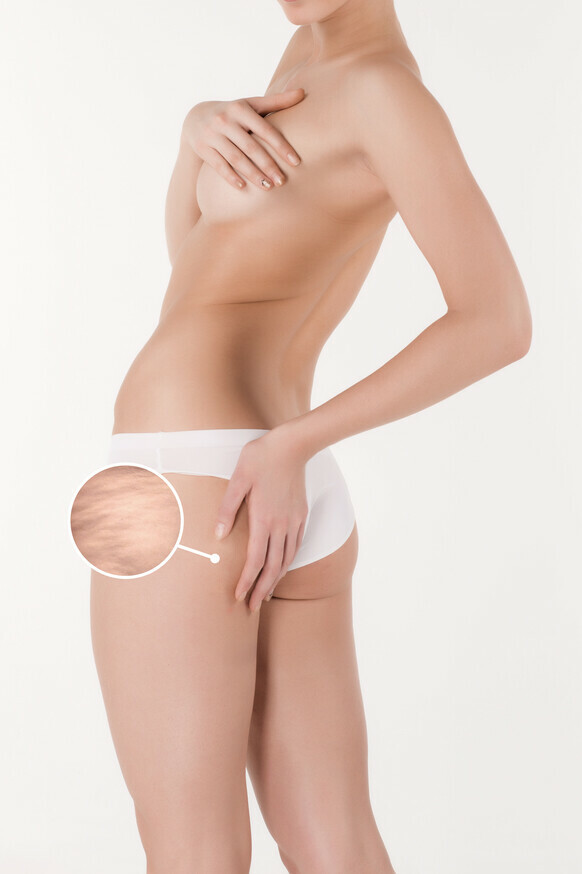I’m going to break down what cellulite really is and why there’s plenty of confusion surrounding it. Cellulite refers to the dimpled, cottage cheese-like appearance commonly found on the thighs, hips, buttocks, and abdomen. It’s caused by the way fat deposits push through connective tissue beneath the skin.

You’re going to find out about the biological process behind the formation of cellulite. It involves fibrous connective cords tying the skin to the underlying muscle, with the fat lying in between. As fat cells accumulate, they push up against the skin, while the long, tough cords pull down. This creates a surface dimpling or puckering you know as cellulite.
This isn’t just about a cosmetic issue; it’s also a complex interplay of genetics, body fat percentage, and age. Many people think cellulite is a sign of being overweight, but even lean and fit individuals can have cellulite due to this intricate combination of factors.
Demystifying the permanence of cellulite involves looking at various elements that influence its presence. The prevalence of cellulite varies widely among different people due to factors like genetic predisposition, skin structure, and hormonal balance.
I’m here to guide you through understanding that having cellulite is incredibly common. It affects up to 90% of women and a smaller percentage of men, especially during hormonal fluctuations such as those experienced during puberty, pregnancy, or menopause. As a normal part of the human body’s variability, it’s crucial to approach the subject of cellulite with fact-based knowledge to manage expectations and maintain a healthy self-image.
Assessing the Permanence of Cellulite

I’m going to give it to you straight: the permanence of cellulite can be a complex topic. Many people wonder if once cellulite appears, is it there to stay? You’re about to find out the whole story.
The severity and longevity of cellulite can differ for each person, and there are several key factors that contribute to this. Genetics, for instance, play a crucial role. If your family members tend to have cellulite, chances are you might too. It really is a ‘like parent, like child’ situation in many cases.
Lifestyle choices are another piece of the puzzle. Regular exercise, maintaining a healthy weight, and a balanced diet might help manage cellulite. But here’s the kicker: they are not a guaranteed fix. They assist in overall skin health, which can reduce the appearance of cellulite, but they’re part of a bigger picture.
Now, let’s talk hormones. They’re like the conductors of the body’s orchestra, and when they change, they can bring cellulite to the forefront. Hormonal shifts, particularly estrogen, may influence cellulite’s prominence during puberty, pregnancy, menopause, or due to birth control usage.
Here’s the bottom line: while some factors are under your control, others, such as genetics and hormonal shifts, are not. So, yes, cellulite might seem permanent, especially if you’re only looking at the factors that are out of your hands.
However, don’t think all hope is lost. Coming up next, I’m going to delve into the myriad of treatments and management strategies out there. You just might find something that resonates with you and fits into your lifestyle. Remember, your first attempt doesn’t have to be your last when it comes to managing cellulite.
Treatment and Management Strategies for Cellulite

So you’re concerned about cellulite and looking for ways to manage it. You’re not alone. There’s a wealth of treatment options out there, and they range from over-the-counter creams to more invasive medical procedures. I’m going to walk you through some of these treatments, but remember, effectiveness can vary widely from person to person.
First up are the countless creams, lotions, and potions promising to smooth out cellulite. Ingredients like caffeine or retinol might have some temporary effects, but don’t expect miracles. These products often offer subtle improvements at best, and it’s crucial to have realistic expectations when using them.
Moving on to professional treatments, we’ve seen innovative techniques like laser therapy, cryolipolysis, and shockwave therapy. These approaches aim to break down fat cells or stimulate collagen production, but they’re not one-size-fits-all solutions. Discuss with a healthcare provider to determine the best route for your situation.
A major player in cellulite management is, without a doubt, lifestyle. Regular exercise, particularly strength training, can help improve muscle tone and reduce the appearance of cellulity skin. Balancing your diet with plenty of hydration, fruits, vegetables, and healthy fats might also assist in keeping your skin healthy and resilient.
In my opinion, managing cellulite is also about managing expectations. Understand that most treatments provide only modest improvement. Don’t fret; focus instead on how you feel, rather than just on how you look. Confidence often shines brighter than any perceived flaw.
Finally, in the grand scheme of treatments, don’t dismiss the psychological component. The stress and anxiety over cellulite can sometimes overshadow the real issue. Holistic approaches, including mindfulness and self-compassion exercises, can help improve your overall well-being and self-image, which is a beautiful thing in itself.
Cellulite: A Comprehensive Perspective on a Common Concern

Cellulite is a completely normal feature of human skin. It’s something that a majority of us, especially women, will encounter at some point in our lives. I’m going to emphasize that cellulite is not an indicator of poor health or lifestyle choices, and it most definitely isn’t something to be ashamed of.
In fact, this isn’t just about skin appearance, it’s also about reshaping societal perceptions and encouraging a heartfelt embrace of body diversity. While the influence of mass media and cultural standards might steer us toward seeking perfection, it’s vital to understand that beauty comes in all shapes, textures, and patterns.
So, what are the key takeaways for anyone grappling with cellulite? Firstly, you’re not alone. Cellulite is as commonplace as freckles or stretch marks. Secondly, while various treatments and lifestyle adjustments can potentially reduce the appearance of cellulite, there’s no guaranteed permanent solution. And that’s okay.
Looking ahead, there’s a lot of opportunity in the field of dermatological research to develop more effective cellulite treatments. As technology and medical understanding progress, we may see new and innovative solutions emerge.
For those who want to learn more or seek guidance, there are numerous support networks and professionals to turn to. Discussing with healthcare providers, connecting with body positivity groups, or even just having open conversations with friends can offer immense support.
I really hope that this exploration helps to demystify cellulite and inspires a more compassionate and realistic dialogue around it. Remember, your body is unique, and its uniqueness is something to be celebrated, not criticized.
If you want to get rid of cellulite fast, check out the resources below:
5 Critical keys to Kill Cellulite
The Best Anti-cellulite Workout
Leave a Reply